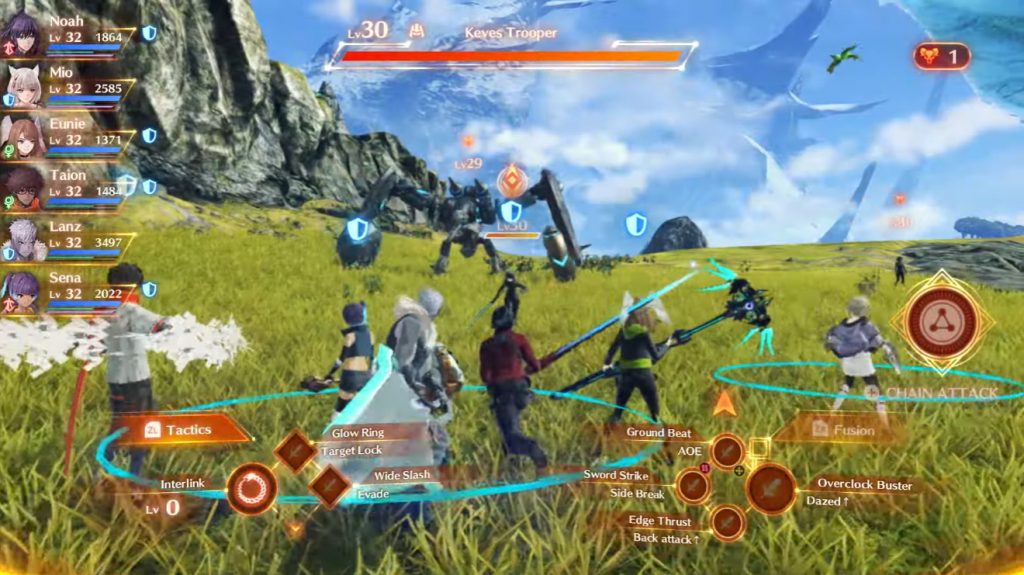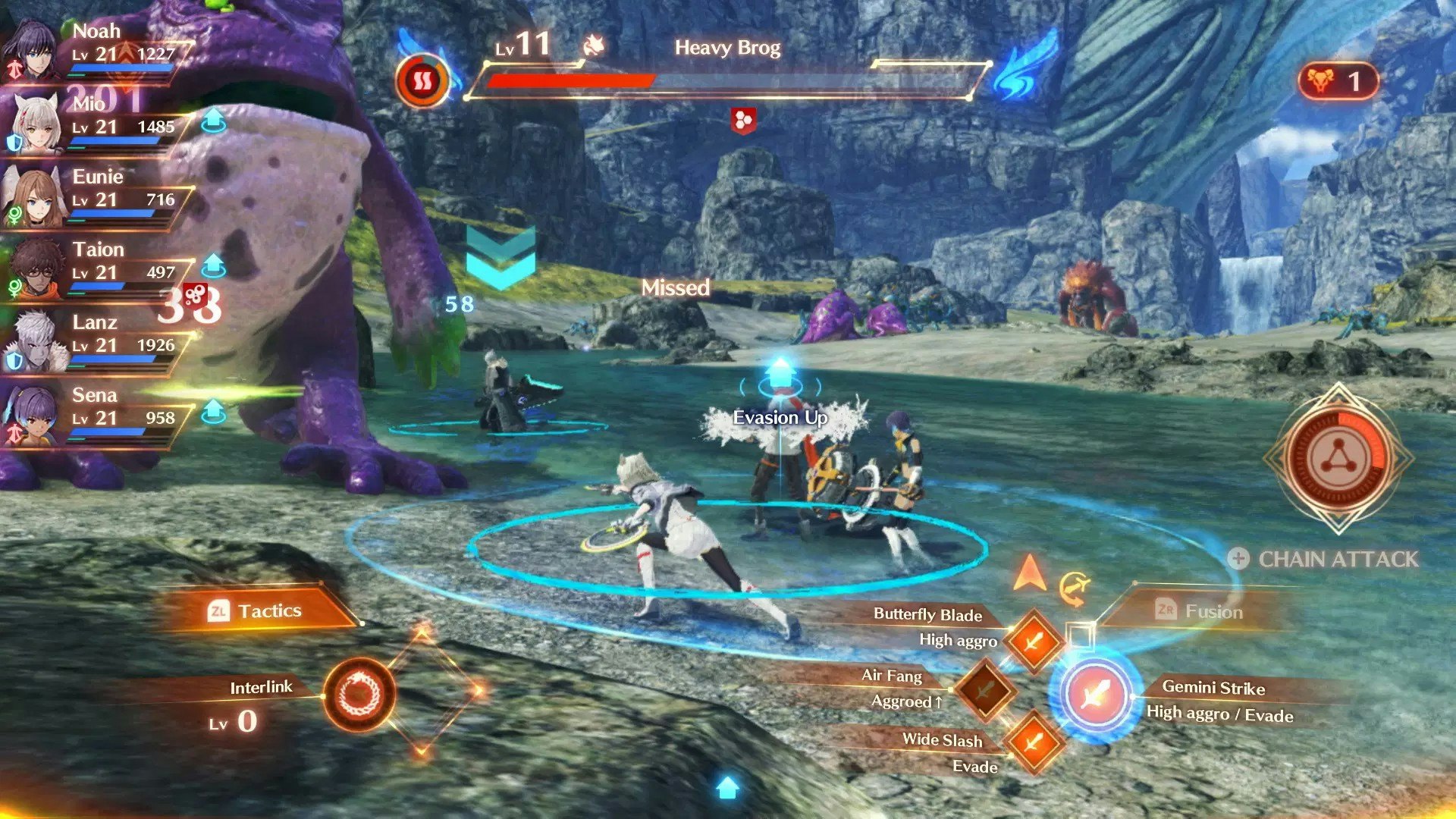
Ten years may seem like an eternity. But what if you only had ten years left to live?From this premise begins the story of Xenoblade Chronicles 3, a treatise on life and death, and the journey that gives true meaning to both.
The story of Xenoblade Chronicles 3 begins with a brutal and solemn account of a war between two desperate sides. On one side is Colony 9, a sub-colony of the nation of Quebecile. On the other side lies Colony Sigma, a newly founded settlement of even lower rank and even fewer resources within the rival nation of Agnus.
With survival at stake, the two sides engage in a fierce battle between infantry and giant machines wreaking havoc on the battlefield. It is in the midst of this scene of carnage and destruction that we get to know our protagonist, Noah, who leads the elite Kebes unit to the front lines. Not only is Noah a skilled warrior, he is also an “Off Seer” whose job it is to send away the souls of the dead. This role gives Noah, who makes no distinction between friend and foe when it comes to carrying out his missions, a more nuanced view of life than the black-and-white perspective instilled in him by his military upbringing.
This perspective also makes Noah question the structure of the world and the country he and his friends call home.
In the world of Aionios with Cebes and Agnus, the cycle of life is fixed and unquestioned. Children are created in capsules and live for ten years, emerging as adult children and becoming instruments in the never-ending war between Cebes and Agnus. Most do not even reach the age of ten, dying usually on the battlefield or in battle with the many dangerous monsters that call Aionios home.
Every ten years, those who survive take part in a ritual called the “Homecoming”, where they abandon their bodies in a spectacular light show and return to nature. Basically, it’s just that you die differently, only on your own terms.
Like a shooting star, the lives of the soldiers of Cebes and Agnus are short but fiery, fulfilling their roles as living weapons every day until they can’t live any longer. While most fully embrace this role and strive to return home, some have doubts and questions. Answering these questions will ultimately drive the plot of Xenoblade Chronicles 3, one of the highlights of the game.
Like a novel in video game form, Xenoblade Chronicles 3’s carefully told story unfolds on screen in numerous scenes, slowly revealing the core of the drama. With behind-the-scenes machinations of those in power, the sad and solemn deaths of friends and foes, and the unlikely but strong friendships forged in the flames of conflict, Xenoblade Chronicles 3’s story is undoubtedly one of its strengths.
Admittedly, the story isn’t perfect. While the story itself is great, the storytelling suffers from losing focus and falling prey to boring tropes often found in Japanese anime. A more anime-like story could be problematic, especially for those who prefer Western-style storytelling in role-playing games.
The English localization is solid overall, offering some funny moments with creative use of slang terms directly from the game’s unique world. At the same time, the localization sometimes takes too many liberties with the translation, especially the dialogue. Of course, as someone who understands Japanese, I understand that you don’t always have to translate everything literally. Frankly, in some cases, it’s necessary for good dialogue. However, such changes should further enhance the narrative, rather than rendering the dialogue contextless or even trivializing it in some cases.
For example, I understand that sweary dialogue needs to be tweaked to reach a wider audience. However, the overuse of terms like “snuff” and “spark” can seem unnatural, and characters can sound strange in English even when the dialogue is perfectly fine in Japanese.
Still, the fact that the game features both English and Japanese voice actors is a plus. The issues I’ve mentioned are minor, and I think the story overall is very well done, especially in portraying the horrors of war and the effect it has on those who fight.
Worldbuilding in Xenoblade Chronicles 3

World-building is a hallmark of the Xenoblade Chronicles series, and Xenoblade Chronicles 3 is no exception.
Like the previous two Xenoblade Chronicles games, Xenoblade Chronicles 3 offers a spectacular world with impressive flora and fauna and breathtaking vistas as far as the eye can see.
Entering Ionios is like stepping into an epic fantasy world populated with vast locations and otherworldly creatures large and small. The scale is evident in the vast overworld, which features not only vast landscapes but also the remains of gigantic creatures towering over the land like mountains. If there’s any reason to experience a game in virtual reality, I’d love to roam the open world of Xenoblade Chronicles 3.
Speaking of world-building, Xenoblade Chronicles 3 follows on from both games in terms of story, so fans of the first two games will be well worth their money. Playing the first two games isn’t necessarily necessary to enjoy this one, but once you’ve experienced it, the homages to those titles become even more impressive.
Xenoblade Chronicles 3 also does a great job of getting the most out of the Nintendo Switch’s performance. It’s showing signs of aging on a five-year-old console that wasn’t even powerful when it was first released, but this is about as good as a Switch game gets. The character models look great, especially in the cutscenes, and make you feel like you’re playing a live anime.
The game’s resolution and texture detail leave a lot to be desired visually, especially when playing docked on a big screen TV, but I also want to commend Monolith Software for making the most of the system. I’m never going to criticize or deduct points from developers who push the limits of a less-powerful system that’s supposed to be portable. For the same reason, I’m not going to downgrade the Switch version of Monster Hunter Rise: Sunbreak, even though the graphics and frame rate of the PC version, which I mostly play, are significantly better.
If you’re going to penalize a game for its graphics on the Switch, I think it makes sense that the graphics are lackluster compared to other Switch games. However, if graphics and visual fidelity are very important to you and you’re okay with that, Xenoblade Chronicles 3 will pale in comparison to the game on a high-end PC, or even the PS5 or the latest Xbox consoles.
Xenoblade Chronicles 3 makes the switch with its class-based gameplay

If you think the world of Xenoblade Chronicles 3 is vast, wait until you see the gameplay.
If you’re about 10 hours into the game and you’re still seeing introductory screens about new gameplay mechanics, you know you’re in for a tough one.
It basically builds on the already clunky systems of the series and adds an interesting class sharing mechanic on top of it.
Essentially, Xenoblade Chronicles 3’s combat will be familiar to veterans of the series. For those who haven’t played the previous game, the game employs a hybrid combat system that essentially combines turn-based and action mechanics. In this respect, it may be reminiscent of some MMO role-playing games.
For example, you can move freely when fighting enemies, which is great for positioning. If you move into range of an enemy and stop, your character will start using auto-attacks. You can also perform special abilities, but they all have a cooldown before they can be used again.
This system may seem simple and even boring at first, especially to players who are used to action games where you can always attack. However, beneath the seemingly simple surface lies a deep combat system that becomes extremely addictive once you unlock all the available options and get used to its intricacies.
For example, some moves deal bonus damage or effects when performed from the side or behind your opponent. You can also cancel a normal attack and convert it into a special move, or convert a special move into another special move if you unlock the feature in the skill tree.

You can also perform combo attacks with your teammates if you use certain moves in sequence; this is something the AI is surprisingly good at. A simple move is to use a move that gives your opponent a break, then use a move that gives a topple, then use a move that gives a daze. Successfully completing the sequence will allow you to lock your opponent in place. Additionally, throwing an enemy up into the air will ensure a 100% chance of hitting and dealing massive damage.
The game also offers different classes with specific roles. These include attacker, tank, and support classes, and you need to use these correctly to fight against stronger enemies in the game.
Finally, you also gain the ability to transform your team members by performing the so-called “Interlink” function with your partner ally during the battle, transforming them into a powerful robot-like creature called Ouroboros. This gives you access to powerful Fusion Arts that can turn the tide of battle with various effects such as buffs and healing.
You can also perform team-wide chain attacks, which allows you to perform multiple special moves in succession to boost your attacks, ignore your opponent’s defense, or reduce your opponent’s “aggression” or attention to a specific team member. These chain combos can be performed by attacking enemies during battle and filling a meter on the right side of the screen.
A particularly cool feature of Xenoblade Chronicles 3 is the ability to share classes between all team members.

The six original classes are initially locked to each main team member, but over time the ability for each character to use all of their teammates’ classes is unlocked. Not only can you level up multiple classes, but you can also learn class-specific skills and reuse them in another class to create a custom character. You can also unlock classes for NPCs known as “Heroes”, such as Silvercoat Ethel’s “Flash Fencer” class. This class sharing mechanic is a lot of fun, even addictive, as you try out all the different class options with all your characters.
Admittedly, all the mechanics available in the game can be a bit overwhelming at times, as there’s a lot to get to grips with. If you only visit the various tutorials to see some of the mechanics, you might lose track of all the features available.
I also miss the movement and attack functionality that was in the original Xenoblade Chronicles, which was removed in Xenoblade Chronicles 2. Admittedly, if you have a full team, this isn’t a big issue. But in tough battles where you only have one character left, it can be useful to attack and move at the same time, rather than standing still when a monster or mob has its 100% focus on you.
But overall, combat is one of the more enjoyable aspects of Xenoblade Chronicles 3. It’s certainly easy to fall down the rabbit hole of trying everything and making the most of your character’s options, and with the addition of crafting and cooking abilities, Xenoblade Chronicles 3 has plenty to keep you busy.
Final thoughts on Xenoblade Chronicles 3
Like its predecessors in the series, Xenoblade Chronicles 3 is an epic. Whether it’s the story, the vast areas and creatures, or the 100+ hours of gameplay, Xenoblade Chronicles 3 offers unparalleled scope. Admittedly, the scope can be intimidating and overwhelming at times. The story also leans into anime tropes and uneven pacing. But overall, the tale impresses with its poignant depiction of war and death. Add to that the refined gameplay and Xenoblade Chronicles 3 has a lot to offer RPG fans.

Leave a Reply